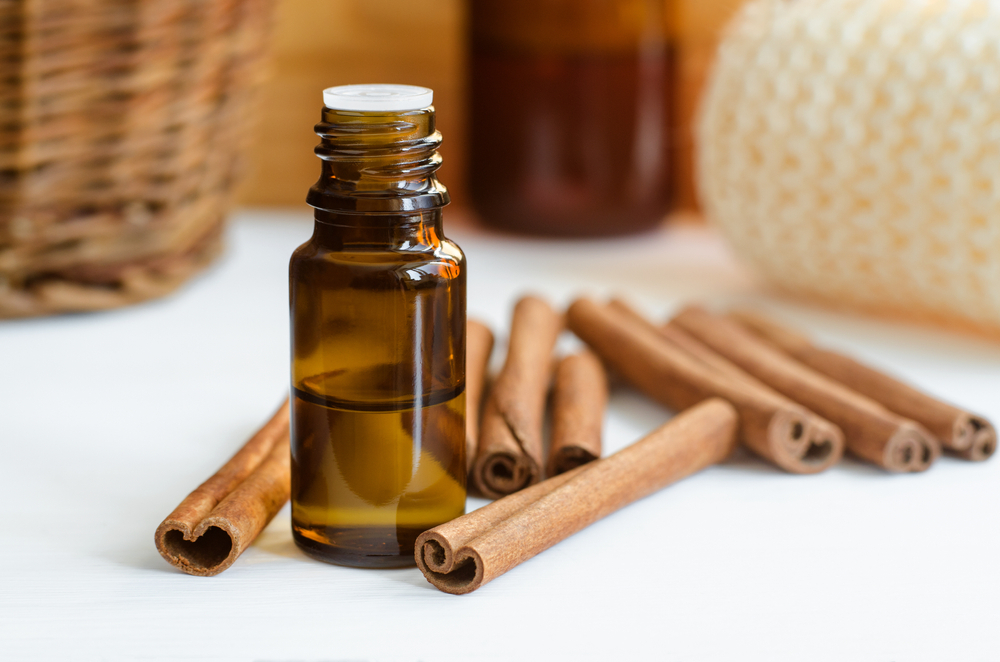Cinnamon oil not only smells fantastic, but can also care for skin and hair in a unique way. We explain why this is so and how it works.
Who doesn’t like the smell of cinnamon? Most of us probably associate it most closely with the Christmas season. However, cinnamon is much more than just an aromatic spice for cookies and co. Especially cinnamon oil has long been considered an effective remedy for body and mind. In addition, the proper use of cinnamon oil also has a beautifying effect on skin and hair.
Cinnamon oil: Effect on skin and hair
Cinnamon oil can support the natural functions of our body and thus also have a positive effect on the condition of skin and hair:
- antioxidants contained in cinnamon oil protect the skin from free radicals, prevent rapid aging of the skin and thus have an anti-aging effect
- the oil strengthens skin, hair and nails
- strengthens blood circulation, thus stimulating hair growth (applied to the scalp) and cell renewal and regeneration of the skin
- supports against hair loss
- gives a rosy, healthy complexion
- cinnamon oil has antifungal and antibacterial effects, which makes it effective against acne, blemishes and rashes
- moisturizes dry skin
The right application for skin and hair
Cinnamon oil can cause allergies
Since cinnamon oil can trigger allergic reactions, you should first only test whether you tolerate the oil on a small area of skin – for example, in the crook of your arm. The skin may tingle after application, but if it burns, itches and reacts with severe redness, the oil must be removed immediately and must not be used further.
Care should also be taken to ensure that the cinnamon oil does not get on the mucous membranes, as these are particularly sensitive. Pregnant women should not use cinnamon oil, as it can trigger uterine contractions.
Always mix cinnamon oil
Never apply the oil pure but always with a carrier oil. For this, mix a few drops of the oil, for example, in jojoba oil, almond oil or coconut oil.
It is also possible to mix the oil into your face care (cream or lotion) as well as your body cream. For hair use, you can simply add a few drops of the cinnamon oil to your shampoo for daily use. A hair mask can also be enhanced by adding a few drops of cinnamon oil. For scalp treatment, it is recommended to mix with a carrier oil. Again, never apply pure to the skin!
DIY beauty applications with cinnamon oil
Instructions: Soothing head massage with cinnamon oil
- 100 ml almond oil
- 1 drop cinnamon oil
Warm the almond oil slightly in a water bath or in the microwave. It should preferably not be much warmer than body warm. Mix the oils together and gently massage the mixture into your scalp. Leave on for 20 minutes and then wash your hair with a gentle shampoo.
Instructions: Cinnamon oil hair treatment for dry hair
- 100 ml coconut oil
- 50 ml almond oil
- or macadamia oil
- 5 drops of cinnamon oil
- 2 tsp honey
Coconut oil is solid at room temperature and should first be warmed in a water bath so that it becomes liquid. Mix it with two teaspoons of honey, the macadamia or almond oil and five drops of cinnamon oil. Spread the fragrant mixture on the hair and also massage the scalp with it. The hair treatment should be absorbed for at least 45 minutes and then washed out with a gentle shampoo. You will achieve an even better effect if you wrap a towel around your head during the application time. Afterwards, you can enjoy shiny, soft hair.
Instructions: Honey cinnamon oil mask for clear skin
- 1 drop cinnamon oil
- 2 tablespoons honey (preferably medically effective honey such as Manuka honey)
Mix the ingredients together and first test in the crook of your arm or wrist to see if the mixture might cause you an allergic reaction. If this is not the case, you can spread the cinnamon oil mask on your previously cleansed face and let it absorb for 10 minutes. After that, wash it off with warm water.
If the mask is good for you, you can gradually increase the exposure time up to 30 minutes. The cinnamon oil face treatment can be used once or twice a week.
Cinnamon oil: Origin, varieties and production
Cinnamon oil can be obtained from different varieties of cinnamon: from the Ceylon cinnamon tree (Sri Lanka) and from the cinnamon cassia the Chinese cinnamon tree. The cinnamon variety Cassia usually contains a high proportion of the toxic substance coumarin. It is therefore preferable to use the harmless but more expensive Ceylon oil.
The cinnamon oil of the Ceylon tree is obtained from the cinnamon bark by steam distillation. The cinnamon bark oil is initially almost colorless and rather thick. Only after a certain storage time does it take on a reddish-brown color and begin to smell of cinnamon.
There is also so-called cinnamon leaf oil, which is obtained from the leaves of the cinnamon tree. This has a strong aromatic scent (reminiscent of the scent of cloves) and is darker than the cinnamon bark oil and also has a stronger antibacterial effect.

